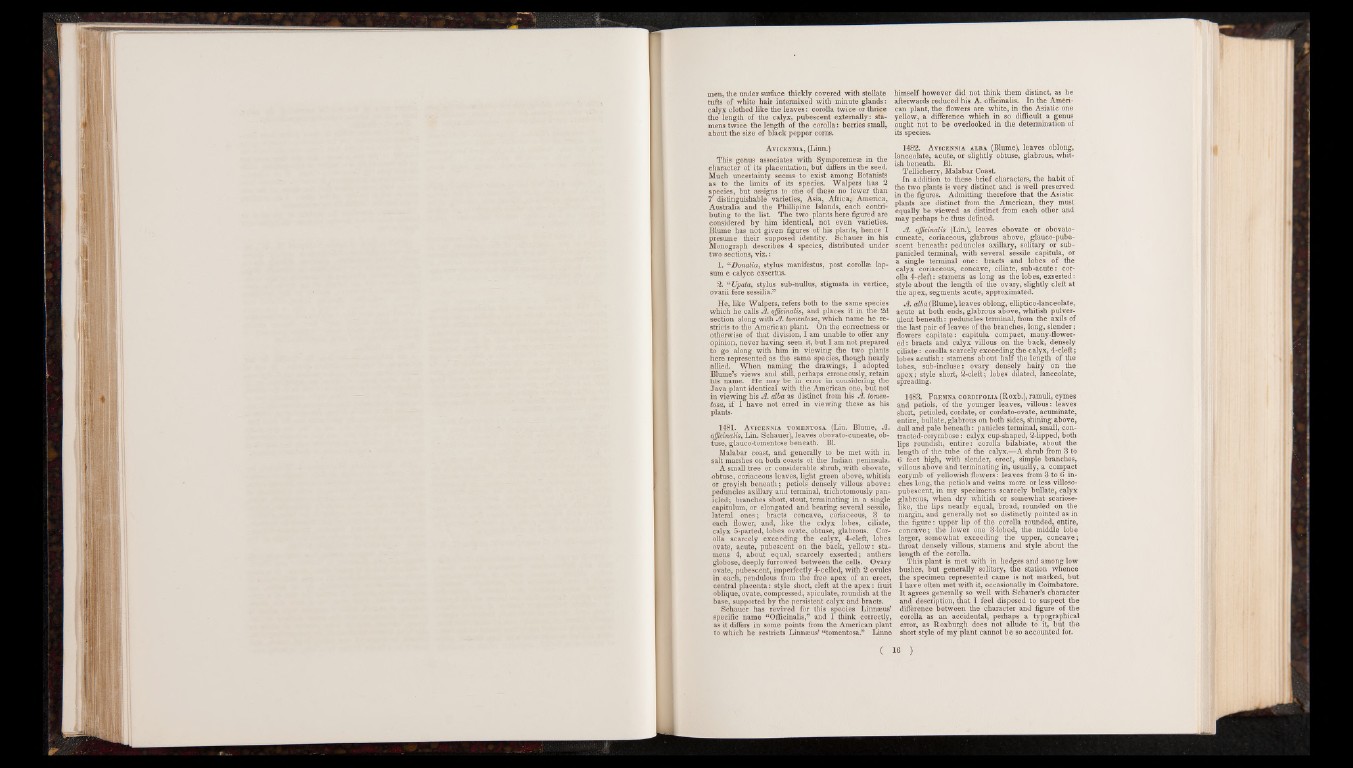
men, the under surface thickly covered with stellate
tufts of white hair intermixed with minute glands:
calyx clothed like the leaves: corolla twice or thrice
the length of the calyx, pubescent externally: stamens
twice the length of the corolla: berries small,
about the size of black pepper corns.
Avicennia, (Linn.)
This genus associates with Symporemeas in the
character of its placentation, but differs in the seed.
Much uncertainty seems to exist among Botanists
as to the limits of its species. Walpers has 2
species, but assigns to one of these no fewer than
7 distinguishable varieties, Asia, Africa, America,
Australia and the Phillipine Islands, each contributing
to the list. The two plants here figured are
considered by him identical, not even varieties.
Blume has not given figures of his plants, hence I
presume their supposed identity. Schauer in his
Monograph describes 4 species, distributed under
two sections, v iz .:
1. “Donatio, stylus manifestus, post corollas lap-
sum e calyce exsertus.
2. “Upata, stylus sub-nullus, stigmata in vertice,
ovarii fere sessilia.”
He, like Walpers, refers both to the same species
which he calls A. officinalis, and places it in the 2d
section along with A. tomentosa, which name he restricts
to the American plant. On the correctness or
otherwise of that division, I am unable to offer any
opinion, never having seen it, but I am not prepared
to go along with him in viewing the two plants
here represented as the same species, though nearly
allied. When naming the drawings, I adopted
Blume’s views and still, perhaps erroneously, retain
his name. He may be in error in considering the
Java plant identical with the. American one, but not
in viewing his A. alba as distinct from his A. tomentosa,
if I have not erred in viewing these as his
plants.
1481. Avicennia tomentosa (Lin. Blume, A .
officinalis, Lin. Schauer), leaves obovato-cuneate, obtuse,
glauco-tomentose beneath. Bl.
Malabar coast, and generally to be met with in
salt marshes on both coasts of file Indian peninsula.
A small tree or considerable shrub, with obovate,
obtuse, coriaceous leaves, light green above, whitish
or greyish.beneath; petiols densely villous above:
peduncles axillary and terminal, trichotomously pan-
icled; branches short, stout, terminating in a single
capitulum, or elongated and bearing several sessile,
lateral ones; bracts concave, coriaceous, 3 to
each flower, and, like the calyx lobes, ciliate,
calyx 5-parted, lobes ovate, obtuse, glabrous. Corolla
scarcely exceeding the calyx, 4-cleft, lobes
ovate, acute, pubescent on the back, yellow: stamens
4, about equal, scarcely exserted; anthers
globose, deeply furrowed between the cells. Ovary
ovate, pubescent, imperfectly 4-celled, with 2 ovules
in each, pendulous from the free apex of an erect,
central placenta: style short, cleft at the apex: fruit
oblique, ovate, compressed, apiculate, roundish at the
base, supported by the persistent calyx and bracts.
Schauer has revived for this species Linnaeus’
specific name “Officinalis,” and I think correctly,
as it differs in some points from the American plant
to which he restricts Linnaeus’ “tomentosa.” Linne
himself however did not think them distinct, as he
afterwards reduced his A. officinalis. In the American
plant, the flowers are white, in the Asiatic one
yellow, a difference which in so difficult a genus
ought not to be overlooked in the determination of
its species.
1482. Avicennia alba (Blume), leaves oblong,
lanceolate, acute, or slightly obtuse, glabrous, whitish
beneath. Bl.
Tellicherry, Malabar Coast
In addition to these brief characters, the habit of
the two plants is very distinct and is well preserved
in the figures. Admitting therefore that the Asiatic
plants are distinct from the American, they must
equally be viewed as distinct from each other and
may perhaps be thus defined.
A. officinalis (Lin.), leaves obovate or obovato-
cuneate, coriaceous, glabrous above, glauco-pube-
scent beneath: peduncles axillary, solitary or sub-
panicled terminal, with several sessile capitula, or
a single terminal one: bracts and lobes of the
calyx coriaceous, concave, ciliate, sub-acute: corolla
4-cleft: stamens as long as the lobes, exserted:
style about the length of the ovary, slightly cleft at
the apex, segments acute, approximated.
A. alba (Blume), leaves oblong, elliptico-lanceolate,
acute at both ends, glabrous above, whitish pulverulent
beneath: peduncles terminal, from the axils of
the last pair of leaves of the branches, long, slender;
flowers capitate: capitula compact, many-flowered:
bracts and calyx villous on the back, densely
ciliate: corolla scarcely exceeding the calyx, 4-cleft;
lobes acutish: stamens about half the length of the
lobes, sub-incluse: ovary densely hairy on the
apex; style short, 2-cleft; lobes dilated, lanceolate,
spreading.
1483. Premna cordifolia (Roxb.), ramuli, cymes
and petiols, of the younger leaves, villous: leaves
short, petioled, cordate, or cordato-ovate, acuminate,
entire, bullate, glabrous on both sides, shining above,
dull and pale beneath: panicles terminal, small, contracted
corymbose : calyx cup-shaped, 2-lipped, both
lips roundish, entire: corolla bilabiate, about the
length of the tube of the calyx.—A shrub from 3 to
6 feet high, with slender, erect, simple branches,
villous above and terminating in, usually, a compact
corymb of yellowish flowers: leaves from 3 to 6 inches
long, the petiols and veins more or less villoso-
pubescent, in my specimens scarcely bullate, calyx
glabrous, when dry whitish or somewhat scariose-
like, the lips nearly equal, broad, rounded on the
margin, and generally not so distinctly pointed as in
the figure: upper lip of the corolla rounded, entire,
concave; the lower one 3-lobed, the middle lobe
larger, somewhat exceeding the upper, concave;
throat densely villous, stamens and style about the
length of the corolla.
This plant is met with in hedges and among low
bushes, but generally solitary, the station whence
the specimen represented came is not marked, but
I have often met with it, occasionally in Coimbatore.
It agrees generally so well with Scnauer’s character
and description, that I feel disposed to suspect the
difference between the character and figure of the
corolla as an accidental, perhaps a typographical
error, as Roxburgh does not allude to it, but the
short style of my plant cannot be so accounted for.